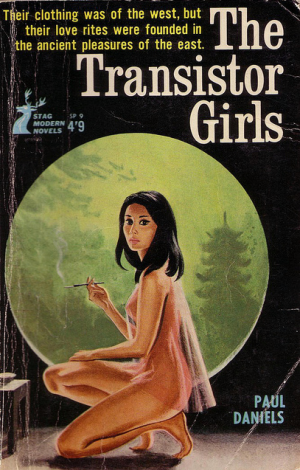 |
THE TRANSISTOR GIRLSA Historical DX Book ReviewBy Jack Mann |
Everyone knows that in 1957 the Soviets started the space race with the launch of the Sputnik 1. But how many of us also know that 1957 was the year the first transistorized shortwave receivers were introduced? First there was the Magnavox AW-100 and a few months later the Zenith Transoceanic Royal 1000.
In the United States, the Association of American Manufacturers of Tube Receivers was quick to see the long-term threat to their business model. And they worked together to come up with a plan to adapt their business and evolve with the changing times.
Ha ha! Just kidding you! Of course the AAMTR saw that they would have to do everything they could to keep this new product out of the hands of consumers. So they began making large financial donations to the relection campaigns of political candidates in hopes of getting laws passed to slow down or stop the spread of these new receivers.
At the same time the AAMTR launched a massive disinformation campaign aimed to convince the general public that they didn't want transistorized receivers. Through paid-for news stories that were carefully placed in newspapers, magazines, radio stations and television, transistorized shortwave radios were associated with the Red Menace. This was moderately successful with older and middle-aged DXers. For example, the August 1958 issue of the Chrome Diner DX Club's bulletin includes an editorial by Elmer Dixon titled Transistorized Shortwave Receivers are a Form of Communism.

|
|
|
The main character in the book is a wholesome twenty-year-old DXer named Tony Harris who is just starting a promising career as an electronics repairman. A new family with teenage daughters (Natasha and Ivona) move to town and they DX on new transistorized receivers. The path of Tony's downfall is set up early in the book when he runs into his best friend, Ralph, at the local hamfest.
"Hey, Ralph! Have you seen those two new girls who just moved here from Maple Grove? They're both hotter than the tubes in an R-390A in July! Natasha has an AW-100 and Ivona has a really hep Royal 1000! ... Wouldn't it be fun to tune their knobs? ... I think they're fast."
"Tony! What are you saying!? You know transistorized radios aren't what God intended us to DX with. Those girls could be part of the Red Menace."
"Well ... the girls do have a strange accent. But it's kind of cute. There's no harm in being friends with them."
"No harm? Did you hear about that guy in Maple Grove?"
"Uh ... no, I didn't."
Fred Morris heard this from his cousin. A couple of his buddies were over in Maple Grove last weekend. Everyone was talking about it at the Soda Shack there.
So ... What happened?
"This guy DXed with those girls one evening on those ... those ... tran-sis-tor-ized shortwave radios. He was listening with headphones and there was that background hiss from the transistors ... He ... went ... deaf!"
"What?! You're shucking me. Aren't you, Ralph? Aren't you?"
"I wish I was, Tony. But's that's the truth ... He'll never DX again!"
"Wow ... never DX again ... Well, things could change. Maybe someone will invent a machine that listens to things like CW and RTTY and translates it into words printed on something like a TV screen. Then a deaf person could still DX."
"Tony! Listen to yourself! Just thinking about those transistor girls is causing you to say crazy things!"
Despite Ralph's warnings and several other ominous events Tony continues to see Natasha and Ivona and begins DXing with them in the evenings after work. He does insist that they listen together with the built-in speakers on the Royal 1000.
As the next few months pass, Tony's friends and family see a change come over him. Then one Saturday when Tony stops by the Soda Shack the guys tell him that he's no longer welcome to sit with them. "He's not the same Tony", says Ralph. Joe Bonfatto adds, "I wouldn't trust him in the same room with my QSL collection."
The next day Natasha and Ivona's family moves out of town. But it's too late for Tony. On Monday morning he's fired from his job at Mr. Hendrick's Repair Shop and on Wednesday he gets home to find that his parents have changed the locks to the house and placed his possessions in a few boxes on the doorstep. The tragic tale ends a few pages later as Tony tries to pawn his Q-Multiplier to buy food.
The AAMTR might have succeeded if they had limited the moral lesson to the evils of transistorized radios. But the people behind the book thought they could better get their message across by connecting transistorized radios with other immoral behaviors, like premarital sex. Which is why the book contained several wild fetish-laced sex scenes involving Tony, the two girls, and the radios. But those pages, of course, were the ones that teenage male DXers read over-and-over-and-over until all they could think of was getting their own transistorized shortwave radios.
So the next time you run into a septuagenarian DXer, ask him about what motivated him to buy his first transistorized radio. I know why I bought mine.




